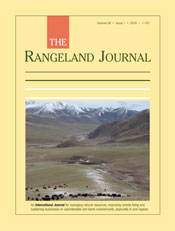
The Rangeland Journal
Volume 38 Number 1 2016
RJ15104Seed bank persistence and germination of chinee apple (Ziziphus mauritiana Lam.)
Chinee apple trees are a scourge on tropical Australia’s woodlands and cattle industry – and with their prolific rate of seed production have the potential to increase their impacts, which already include reduced stocking rates, impeding mustering and restricting water access. This paper explores three experiments related to the seed dynamics of chinee apple and its propensity to remain viable under different conditions. While findings do indicate that chinee apple could expand its distribution to cooler areas, annual control activities should be sufficient to ensure that new plants do not produce and replenish soil seed banks.
RJ14124The impact of recent volcanic ash depositions on herbivores in Patagonia: a review
RJ15081The potential distribution of the woody weed Calotropis procera (Aiton) W.T. Aiton (Asclepiadaceae) in Australia
Rubber bush infests 3.7 million ha of pastoral land in northern Australia. We modelled its potential distribution under current and future climates. Although widespread across north Australia, models show that rubber bush has not saturated its current potential distribution. However, under future climates it will spread into all three states surrounding the Northern Territory, but mostly into north-eastern Western Australia and north-western Queensland. Joint management of rubber bush at a regional scale and across jurisdictions, is urgently advised.
RJ15065Effects of fenced seed production areas and restoration treatments on the size and composition of the native grass seedbanks in moderately degraded rangelands in semiarid Australia
Fencing of topographically high areas with remnant perennial grasses, and implementation on surrounding slopes of mechanical pitting and piles of fine shrub branches led to an increase in size of the seedbank on the slopes (initially almost bare of preferred grasses). Pits favoured incorporation of the unpreferred No. 9 wiregrass and the piles of branches favoured incorporation of the preferred species Mulga oats. The treatments were more effective on a hard-setting red earth than a medium-textured lithosol.
RJ15069Individual and social optima of rural land allocation by stakeholders: a case study on eco-fragile areas of northern China
The divergence in preferences over rural land allocation among stakeholders is getting stronger with the decrease in available rural land, especially in populous countries. This paper explores individual optima and social optima of rural land allocation by different stakeholders in China, presenting the degree of divergence among stakeholders. The analysis provides policy insights that may help to achieve efficient land allocation while jointly considering all stakeholders’ ecological and economic preferences.
RJ15039Cattle removal in arid Australia benefits kangaroos in high quality habitat but does not affect camels
Destocking may not alter grazing impacts on vegetation if introduced or native herbivores replace cattle. After less than 5 years of cattle removal no compensatory use of habitats by either kangaroos or camels was found, but there was higher kangaroo activity in high quality habitat while camels were not affected by continuous cattle grazing or cattle removal. Methods to improve the monitoring of large herbivores in the presence and absence of livestock to assess conservation goals are discussed.
RJ15045Comparing fixed and flexible stocking as adaptations to inter-annual rainfall variability in the extensive beef industry of northern Australia
This simulation study compared the pasture condition and cattle productivity achieved by fixed stocking (attempting to maintain a constant herd size from year-to-year) at the long-term carrying capacity with that of 55 flexible stocking strategies at 28 locations across Queensland and the Northern Territory. Constrained flexibility, which limited increases in stocking rates after good growing seasons to 10% but decreased them by up to 20% after poor growing seasons, provides sustainable productivity gains for cattle producers in northern Australia.
RJ15090Chemical composition of Salicornia arabica (L.), a potential halophyte for arid rangelands
Salicornia arabica L. (Amaranthaceae) produce high edible biomass in Algerian arid rangelands where non-halophytic species cannot grow. This species was qualified as a potential source of major (K, Ca) and trace elements (Fe, Zn, Co) for small ruminants. However, high Na content and probable secondary metabolites (e.g. oxalates) can reduce their digestibility and enhance the amounts of drinking water. Appropriate mixing of this shrub with non-halophytic forage species, could minimise the negative effects of these components.



